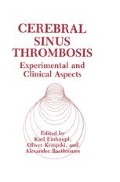Abstract
Arterial as well as tissue hypoxia induces vasodilation and a subsequent increase of blood flow in several organs [2,5,7,11,13]. In brain tissue regional blood flow increases significantly if the arterial oxygen falls below 60 mmHg. In the presence of hypoxia severe enough to cause anoxia in single cells, characteristic metabolic changes develop in cerebral cortex. Therefore, adjustment of the vascular system under these conditions is usually attributed to metabolic factors [9]. Among these K+, H+ ions, and adenosine seem to play an important role [2,7,13].
Access this chapter
Tax calculation will be finalised at checkout
Purchases are for personal use only
Preview
Unable to display preview. Download preview PDF.
References
A. J. Block, H. Feinberg, K. Herbaczynska-Cedro and J. R. Vane, Anoxia-induced release of prostaglandins in rabbit isolated hearts, Circ. Res., 36: 34–42 (1975).
D. W. Busija and D. D. Heistad, Factors involved in the physiological regulation of the cerebral circulation, Rev. Physiol. Biochem. Pharmacol., 101: 161–211 (1984).
R. Busse, U. Förstermann, H. Matsuda and U. Pohl, The role of prostaglandins in the endothelium-mediated vasodilatory response to hypoxia, Pflugers Arch., 401: 77–83 (1984).
R. Detar, Mechanism of physiological hypoxia-induced depression of vascular smooth muscle contraction, Am. J. Physiol., 238: H761 - H769 (1980).
B. R. Duling, Oxygen sensitivity of vascular smooth muscle. II. In vivo studies, Am J. Physiol., 227:42–49 (1974).
R. F. Furchgott and J. V. Zawadzki, The obligatory role of endothelial cells in the relaxation of arterial smooth muscle by acetylcholine, Nature, 288: 373–376 (1980).
J. Grote, Cerebral blood flow regulation under conditions of arterial hypoxia, in: “Cerebral Blood Flow”e Arterial System”, R. D. Bauer and R. Busse, eds., Springer, Berlin, Heidelberg and New York, pp 209–215 (1978).
J. Grote, K. Zimmer and R. Schubert, Effects of severe arterial hypocapnia on regional blood flow regulation, tissue PO2 and metabolism in the brain cortex of cats, Pflugers Arch., 391: 195–199 (1981).
J. Grote and R. Schubert, Regulation of cerebral perfusion and PO2 in normal and edematous brain tissue, in: “Oxygen Transport to Human Tissue”, J. A. Loeppky and M. L. Riedesel, eds., Elsevier North Holland, Amsterdam, New York and Oxford, pp 169–178 (1982).
P. Hellstrand, B. Johansson and K. Norberg, Mechanical, electrical and biochemical effects of hypoxia and substrate removal on spontaneously active vascular smooth muscle, Acta Physiol. Scand., 100: 69–83 (1977).
W. F. Jackson and B. R. Duling, The oxygen sensitivity of hamster cheek pouch arterioles. In vitro and in situ studies, Circ. Res., 53:515–525 (1983).
A. Kurtz, W. Jelkmann, J. Pfeilschrifter and C. Bauer, Role of prostaglandins in hypoxia-stimulated erythropoietin production, Am. J. PhysioL, 249: C3 - C8 (1985).
W. Kuschinsky and U. Wahl, Local chemical and neurogenic regulation of cerebral vascular resistance, PhysioL Rev., 6: 202–211 (1978).
T. A. McCalden, R. G. Nath and K. Thiele, Prostacyclin and vasodilator mechanisms in the cerebral circulation, Blood Vessels, 20: 202 (1983).
R. M. J. Palmer, A. G. Ferrige and S. Moncada, Nitric oxide release accounts for the biological activity of endothelium-derived relaxing factor, Nature, 327: 524–526 (1987).
J. D. Pickard, Role of prostaglandins and arachidonic acid derivatives in the coupling of cerebral blood flow to cerebral metabolism, J. Cereb. Blood Flow Metab., 1: 361–384 (1981).
G. M. Rubanyi and P. M. Vanhoutte, Hypoxia releases a vasoconstrictor substance from the canine vascular endothelium, J. PhysioL, 364: 45–56 (1985).
K. Schrör, Prostaglandine und Endothelzellen, Z. Kardiol., Suppl. 7: 93–97 (1984).
G. Siegel, Membranphysiologische Grundlagen der peripheren Gefässregulation, Physiologie aktuell, 1: 31–52 (1986).
G. Siegel, R. Ehehalt and H. P. Koepchen, Membrane potential and relaxation in vascular smooth muscle, in: “Mechanisms of Vasodilatation”, P. M. Vanhoutte and I. Leusen, Karger, Basel, pp 56–72 (1978).
G. Siegel and J. Grote, Hypoxia effects hyperpolarization and relaxation in canine vascular smooth muscle, Fed. Proc., 46: 507 (1987).
G. Siegel, J. Grote, K. Zimmer, A. Adler and B. Litza, Electrophysiological effects of hypoxia on vasocular smooth muscle, in: “Vasodilatation”, P. M. Vanhoutte, ed., Raven Press, New York, pp 371–376 (1988).
G. Siegel, G. Stock, F. Schnalke and B. Litza, Electrical and mechanical effects of prostacyclin in the canine carotid artery, in: “Prostacyclin and its Stable Analogue Iloprost”, R. J. Gryglewski and G. Stock, Springer, Berlin, pp 143–149 (1987).
P. M. Vanhoutte, Effects of anoxia and glucose depletion on isolated veins of the dog, Am. J. Physiol., 230: 1261–1268 (1976).
P. M. Vanhoutte, The end of the quest?, Nature, 327: 459–460 (1987).
P. M. Vanhoutte, G. M. Rubanyi, V. M. Miller and D. S. Houston, Modulation of vascular smooth muscle contraction by the endothelium, Ann. Rev. Physiol., 48: 307–320 (1986).
Author information
Authors and Affiliations
Editor information
Editors and Affiliations
Rights and permissions
Copyright information
© 1990 Springer Science+Business Media New York
About this chapter
Cite this chapter
Grote, J., Siegel, G. (1990). Vascular Smooth Muscle Reactivity in Hypoxia. In: Einhäupl, K., Kempski, O., Baethmann, A. (eds) Cerebral Sinus Thrombosis. Springer, Boston, MA. https://doi.org/10.1007/978-1-4684-8199-0_9
Download citation
DOI: https://doi.org/10.1007/978-1-4684-8199-0_9
Publisher Name: Springer, Boston, MA
Print ISBN: 978-1-4684-8201-0
Online ISBN: 978-1-4684-8199-0
eBook Packages: Springer Book Archive

